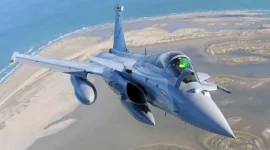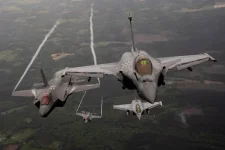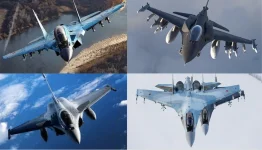- Views: 5K
- Replies: 18
The Indian Air Force (IAF) is taking significant steps to modernise its transport aircraft fleet, with official sources confirming that India has requested a formal proposal from Japan for its Kawasaki C-2 military transport aircraft.
This development is a key part of the IAF's programme to find a successor for its aging Soviet-era Ilyushin IL-76 heavy-lift aircraft, which are anticipated to begin retirement by 2030.
The move also coincides with a broader reassessment of the IAF's Medium Transport Aircraft (MTA) requirements as it seeks to update its capabilities, which currently rely on the IL-76 and the Antonov An-32 aircraft.
The IAF's fleet modernisation is a multi-pronged effort. The locally manufactured Airbus C-295M aircraft are already slated to take over from the older Avro HS-748 fleet.
Now, the air force is considering how to best consolidate its tactical and strategic airlift capacities. This could involve using the C-295M to also replace the An-32 fleet, while a more robust platform like the Kawasaki C-2 is being evaluated to fulfil the strategic roles currently undertaken by the IL-76.
Strategic airlift capabilities are crucial for rapidly deploying troops, equipment, and humanitarian aid over long distances, forming a vital component of a nation's defence posture.
Developed by Kawasaki Aerospace for the Japan Air Self-Defence Force (JASDF), the Kawasaki C-2 is a modern, mid-size military transport aircraft engineered for long-distance and high-speed missions. It is powered by two General Electric CF6-80C2K turbofan engines.
The aircraft boasts a significant maximum payload capacity, reported between 36 and 37.6 tonnes, which is comparable to the 48-tonne capacity of the older IL-76MD variant currently operational with the IAF.
Key performance indicators for the C-2 include a top speed of 890 km/h, a flight range of 6,500 kilometres, and an operational service ceiling of 12,200 metres. These features provide versatility for a range of both tactical and strategic air transport duties.
Furthermore, its capability to operate from shorter or less prepared runways enhances its suitability for India’s diverse geographical and operational terrains.
Japan has been keen to find international buyers for its C-2 aircraft. According to IAF officials, the Japanese aircraft could potentially meet the force's operational needs at a more economical price point compared to other contenders, such as the Airbus A400M.
A significant advantage of the C-2 lies in its fuel-efficient CF6-80C2K engines, which offer better performance and lower running costs than the IL-76's older D-30KP engines.
These Soviet-era engines have been a factor in the IL-76's declining availability rates, which reportedly fell to as low as 32.16% over the last decade due to challenges in maintenance and obtaining spare parts following the dissolution of the Soviet Union.
This interest in Japanese hardware also reflects a wider trend among nations to diversify their sources of defence equipment.
Currently, the IAF's transport aircraft inventory includes over 100 An-32s, 14 operational IL-76s, 11 C-17 Globemaster III heavy lifters, 12 C-130J Super Hercules tactical transports, and 56 Avro HS-748s.
The Avro aircraft are being systematically replaced by the C-295M under a significant contract valued at ₹21,935-crore, signed in 2021 with Airbus Defence and Space.
The C-295M, which has a payload capacity of 9.5 tonnes, is primarily designed for tactical missions. Highlighting the "Make in India" initiative in defence, these aircraft are being assembled in Vadodara by Tata Advanced Systems Limited (TASL), with the first indigenously assembled unit anticipated by September 2026.
Sources indicate that the IAF now views the C-295M as a suitable candidate to potentially replace the An-32 fleet as well, considering the An-32s' age—many have been in service since the 1980s—and their decreasing operational readiness.
Despite their advancing age, the IL-76 aircraft, which were inducted into the IAF between 1985 and 1989, continue to be vital assets for heavy-lift strategic airlift operations. The IAF is planning to phase out some of these aircraft starting in 2030, as they will have completed over 40 years of service, a common lifespan consideration for military transport aircraft.
In a move to maintain operational capability in the interim, the IAF approached Russia in March 2024 to explore the possibility of extending the technical service life of 11 IL-76MD aircraft.
However, the long-term strategy necessitates acquiring a modern replacement. The Kawasaki C-2's payload capacity, while marginally less than that of the IL-76MD, makes it a strong contender, particularly given its contemporary design, advanced avionics, and greater operational efficiency.
The IAF's original Medium Transport Aircraft (MTA) tender was aimed at procuring a platform in the 18-30 tonne payload category to replace both the An-32 and IL-76 fleets. This tender attracted interest from several global aerospace firms, including Lockheed Martin with its C-130J-30 Super Hercules, Embraer with the KC-390 Millennium, and Airbus with the A400M Atlas.
However, with a payload capacity of 37 tonnes, the A400M somewhat exceeds the initial MTA specifications, positioning it more as a direct successor for the IL-76's heavy-lift role. The Kawasaki C-2, offering a capacity of 36-37.6 tonnes, aligns more directly with the IL-76MD's capabilities and, according to IAF officials, presents a potential cost advantage over the A400M.
While the Airbus A400M is a highly capable aircraft, known for its versatility with an extended range of 8,900 km and the ability to transport heavy and outsized cargo, it generally comes with a higher acquisition and operational cost.
In contrast, the Kawasaki C-2's fuel-efficient engines and potentially lower purchase price make it an appealing option for the IAF, which is carefully balancing its modernisation goals with budgetary realities.
Japan's willingness to export the C-2 is also consistent with its evolving national defence policy, which now allows for broader defence equipment and technology transfers, as previously demonstrated in its marketing efforts for the aircraft to nations like Saudi Arabia.




